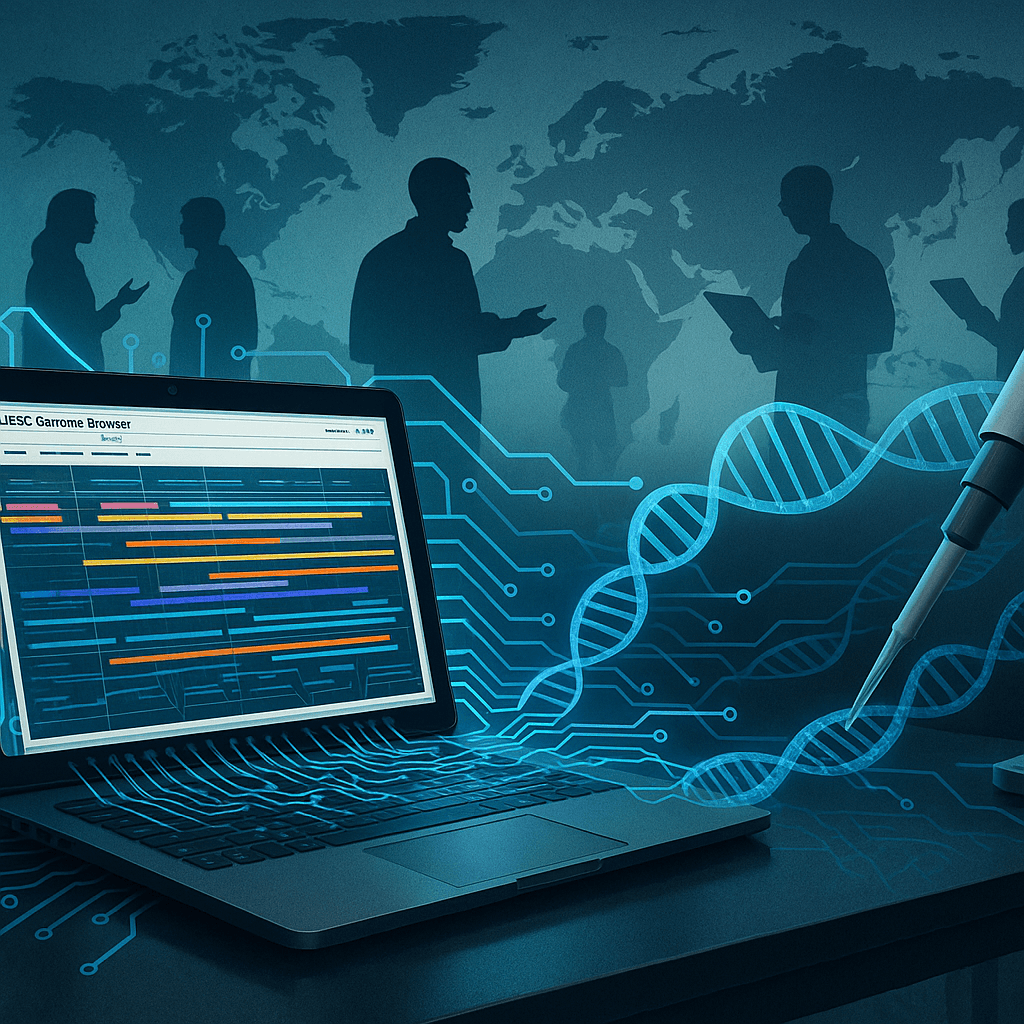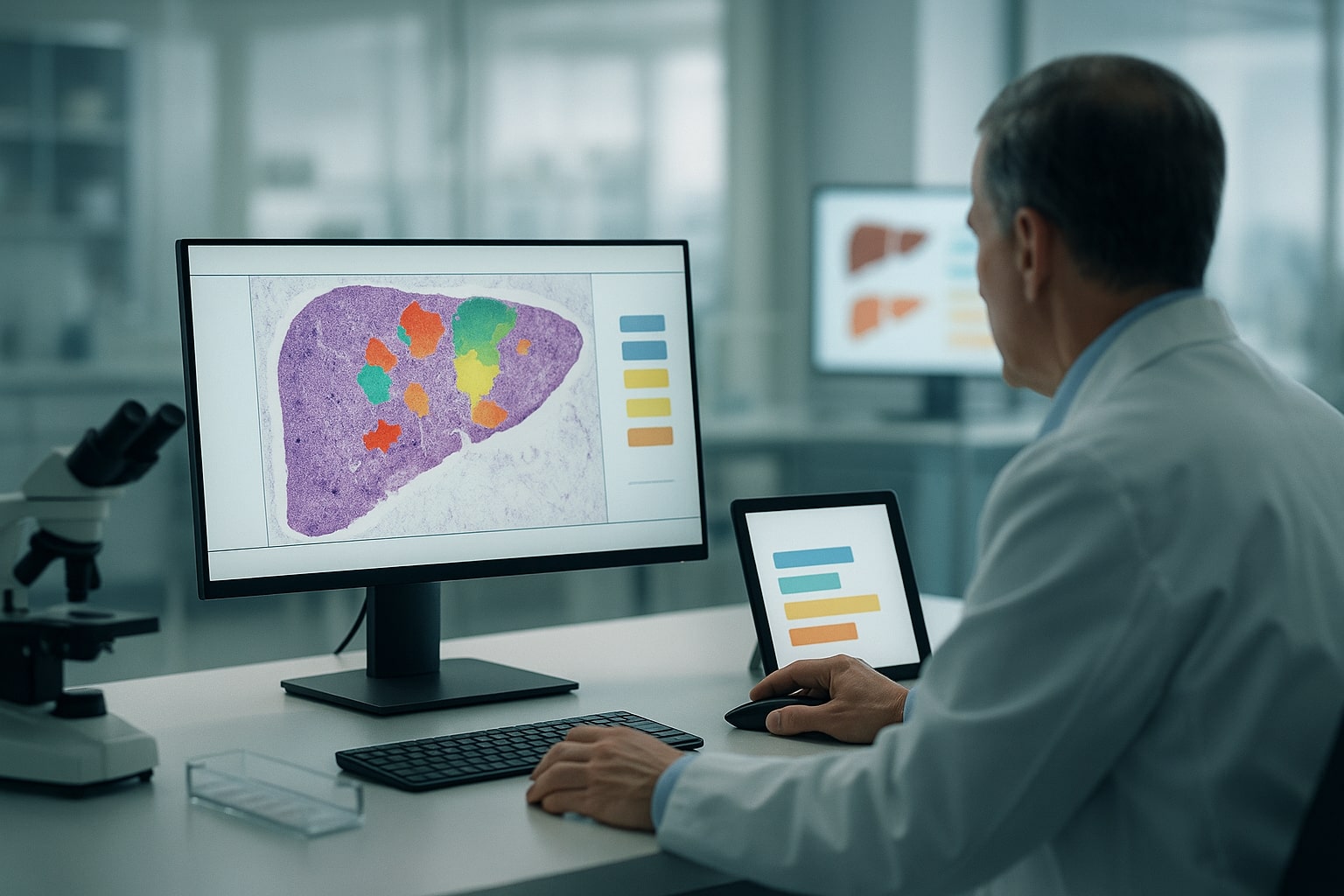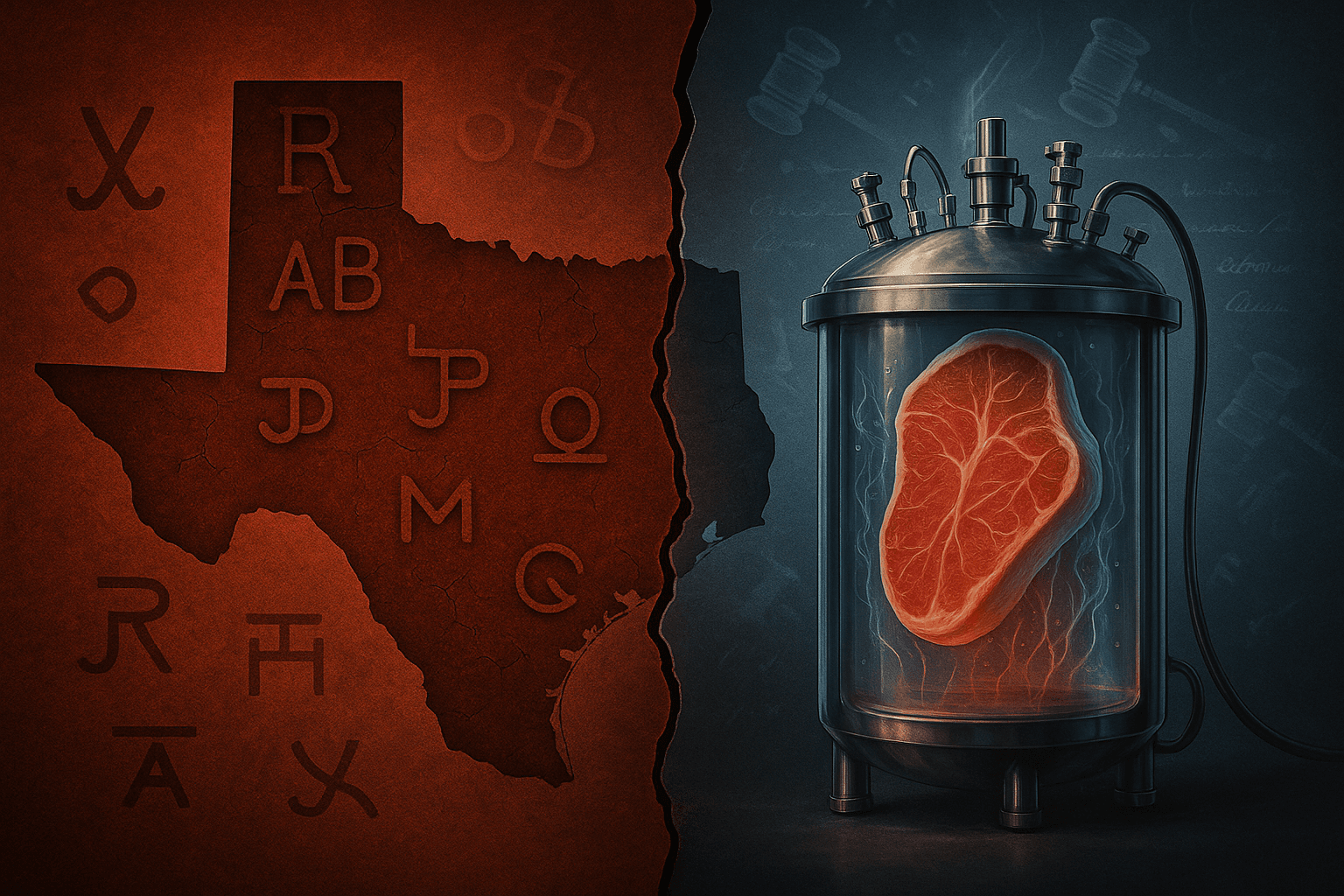Table of Contents
ToggleCRISPRware Signals a New Era in Democratized Gene Editing
In early 2025, a quiet revolution in gene editing arrived via a piece of software called CRISPRware. Developed at UC Santa Cruz and released as open-source, CRISPRware is designed to let scientists anywhere generate entire libraries of CRISPR guide RNAs (gRNAs) for virtually any gene or genome. Importantly, it isn’t locked behind a paywall or a proprietary platform – it’s freely available and even integrated into the widely used UCSC Genome Browser, meaning that with a few clicks, researchers can visualize and select optimized CRISPR target sites across the genomes of multiple organisms. In a field where cutting-edge tools often debut as commercial products or limited web services, CRISPRware’s open release stands out. The tool leverages big data (like large sequencing datasets) to design context-specific guides and even account for genetic variations between strains or individuals. The result is that even complex tasks – for example, designing allele-specific gRNAs that distinguish between two versions of a gene – become accessible on a standard laptop. As the creators put it, CRISPRware makes these high-throughput guide design capabilities widely available, hosting pre-scored gRNA libraries for six model organisms in a public UCSC Genome Browser session and enabling anyone to run the software on their own modest computers.
This development is emblematic of a broader trend: the “open-sourcing” of biotechnology tools. Just as open-source software transformed computing by lowering barriers to entry, open-source biology tools are now democratizing who can participate in advanced research. CRISPRware’s debut within the UCSC Genome Browser – a free web-based platform used by genomic scientists worldwide – means that a grad student in Nigeria or a small biotech startup in South America has the same ability to design CRISPR experiments as a well-funded lab at MIT. “Genome-scale” CRISPR libraries, once the province of elite centers with custom code, can now be crafted anywhere without waiting for a central institute or company to provide the data. This democratizing effect is deliberate. The UCSC team explicitly designed CRISPRware to be flexible and to overcome the limits of existing tools, which often forced scientists to rely on pre-made libraries or clunky servers. Prior web portals like CRISPOR and CRISPick were limited to a few genomes or a few hundred targets per run, and generally lacked user customization. Local command-line tools existed but many hadn’t kept up with the latest improvements in on-target efficacy prediction or off-target avoidance. CRISPRware changes the game by packaging state-of-the-art scoring algorithms and making them easy to use on one’s own data. In short, it gives researchers full control – they can design guides for any gene in any species, fine-tune parameters, and even incorporate their own sequencing data for context. By releasing it open-source (with code on GitHub) and embedding it in a familiar interface (the Genome Browser), the creators aimed to “facilitate the widespread use of CRISPRware,” allowing even those with limited computing resources to participate. It’s a powerful example of how open infrastructure can lower hurdles in science.

Open-Source Infrastructure: From Genomes to Lab Benches
CRISPRware is part of a larger movement toward open-source infrastructure in biotech, a movement that draws explicit parallels with the software industry. In the world of computing, open-source projects like Linux or Apache played a key role in spreading advanced capabilities far and wide, enabling innovation even in small startups or far-flung communities. Now biotech is seeing its own open-source wave, from gene editing software to lab hardware. The ethos is the same: empower users through transparency, share knowledge freely, and accelerate innovation by building communities rather than guarding IP closely.
We’ve already seen open-source principles spreading in biotech software. For instance, the crisprVerse project – a suite of R packages – provides a comprehensive, open-source ecosystem for CRISPR guide design supporting many CRISPR variants and enzymes. It unifies dozens of methods under one umbrella, freely available to any researcher. In the computational biology world, there’s now a rich landscape of such tools, from genome assemblers to image analysis, being developed in the open. CRISPRware’s arrival takes this a step further by integrating open software with a major public platform (UCSC Genome Browser), effectively injecting open capabilities into a tool that biologists already use daily for genomic reference data. The effect is synergistic: if you’re browsing a gene in UCSC’s database, you can immediately see potential CRISPR targeting sites in that gene thanks to CRISPRware’s public tracks. The integration of open CRISPR tools into open genomic databases creates a virtuous cycle of accessibility. It’s analogous to having an open-source plug-in in your web browser – except here the “browser” is for genomes, and the plug-in lets you design genome edits on the fly.
Lowering Barriers for Small Labs and Global Researchers
One of the most profound impacts of open-source biotech tools is the way they lower barriers to entry for scientists who lack hefty funding or institutional support. Ten years ago, a small lab that wanted to do a CRISPR screen (testing thousands of guide RNAs to see which affect a given disease outcome) might need to collaborate with a genome center or use a paid service, simply because designing the library and ensuring its quality was beyond their means. Today, that same lab can fire up CRISPRware, design a whole gRNA library with cutting-edge scoring models, and get a ranked list of guides to test – all for free. Similarly, the lab can use crisprVerse or other open packages to double-check off-targets or to design guides for newer CRISPR systems like Cas13, without needing to license specialty software.
The global reach of such tools is already evident. According to UCSC’s publication, the CRISPRware team has made pre-designed guide sets for human, mouse, zebrafish, fruit fly, and other key organisms openly accessible as Genome Browser tracks. That means a researcher in, say, Brazil working on zebrafish genetics can pull up a publicly available session and instantly find high-scoring CRISPR sites for their gene of interest. They benefit from the heavy lifting (big-data analysis, machine learning scoring of guides) done by the CRISPRware developers and shared freely with the world. This levelling of the playing field can’t be overstated – it helps talent anywhere contribute to science, rather than only those at wealthy centers.
The story is similar in lab automation. Traditional liquid-handling robots ar prohibitively expensive, require weeks of training, and are decidedly not open-source, meaning most labs worldwide simply went without. As a consequence, even PhD-level scientists wasted countless hours on manual pipetting, and only elite labs could afford to automate. Opentrons changed that by introducing robots priced in the low thousands of dollars and releasing the software and hardware specs openly. Drew Endy, a pioneer in synthetic biology at Stanford, highlighted the significance: “For us, the OT-2 means that anyone who can afford a laptop computer can also establish an open biofoundry.” In other words, if you can outfit your lab with basic computers, now you can also equip it with a robotic lab assistant – something previously unimaginable for a small-budget lab. This has enabled tiny startups and even community DIY-biology spaces to perform complex experiments.
Open-source biotech tools also tend to foster communities of users who share improvements and protocols. CRISPRware is open-source, where researchers can tweak its code or add modules to support new CRISPR enzymes, and then share those enhancements with others. This stands in stark contrast to closed commercial tools that evolve slowly (if at all) and can’t be customized by users. The collaborative ethos – scientists helping scientists by contributing code or protocols – is greatly enabled by open licensing. In turn, this accelerates innovation: a grad student in one lab might add a feature to CRISPRware that benefits hundreds of other labs encountering the same problem, without anyone having to seek permission or pay fees.
Real-world examples illustrate how lower barriers spark innovation. A particularly striking case comes from the startup Inscripta. In 2017, Inscripta announced it would give away a new CRISPR enzyme, MAD7, for free – even to commercial users – explicitly to “democratize genome editing” and spur more research. This was a bold departure in a field tangled by patents. Inscripta’s CEO Kevin Ness likened the strategy to “selling pickaxes during a gold rush”: the company’s business would come from selling instruments and software, but first they needed to remove barriers (like restrictive enzyme licenses) that were “back-breaking” for smaller players. The response was telling: Inscripta received emails from researchers saying the free enzyme “enabled [our] business to live” where previously they couldn’t afford the licensing terms. By open-sourcing key IP (or at least making it free to use), Inscripta created a bigger market for its other products and allowed young companies and academic labs to start experimenting without legal roadblocks. It’s a model that is increasingly common – provide a core tool openly to drive adoption, then build value around it. We see similar thinking in the OpenCRISPR initiative by Profluent Bio: the startup used AI to design a novel CRISPR-Cas9-like enzyme and then open-sourced it as “OpenCRISPR-1” with the goal of “spur[ring] innovation and democratization in gene editing”, in the words of CEO Ali Madani. The AI-designed enzyme carried over 400 mutations distinguishing it from natural Cas9 and showed 95% less off-target activity in tests, yet Profluent chose to make it a public good. Their view, as stated in a Fierce Biotech report, is that doing so will broaden the CRISPR toolbox available to everyone and accelerate discoveries, which ultimately benefits the company through downstream partnerships and an enhanced reputation.
To summarize this burgeoning open toolbox, consider a few emblematic examples:
- CRISPRware (UCSC) – Open-source gRNA design software integrated into UCSC Genome Browser, allowing any lab to create custom CRISPR libraries with state-of-the-art accuracy. By embracing openness, it lets researchers target any genome or transcript with flexibility beyond older limited web tools.
- OpenCRISPR-1 (Profluent Bio) – An AI-generated Cas9-like editor released under an open license. It demonstrated comparable efficacy to natural Cas9 with significantly improved specificity (up to 95% reduction in certain off-target edits). Profluent’s open release aims to catalyze research using this enzyme worldwide, free from patent thickets, while showcasing the power of AI in protein design.
- MAD7 Enzyme (Inscripta) – A novel CRISPR enzyme provided free for any academic or commercial R&D use. By removing IP barriers, Inscripta enabled smaller companies and labs to pursue gene editing projects that were previously cost-prohibitive. This open availability also served Inscripta’s interests by growing the customer base for its lab equipment (the “razor and blades” strategy of biotech).
- Opentrons OT-2 Robot – A $15,000 open-source lab robot that performs automated pipetting, making lab automation attainable for small labs (contrast this with legacy robots 10× the price). Opentrons’ software and hardware are openly published, and a community of scientists share protocols on its platform. The company’s mission statement is literally to “democratize sophisticated biotech tools”, turning what used to be a capital investment the size of a luxury car into something as common as a PCR machine. The result: thousands of these robots are now accelerating experiments in over 3,000 labs globally, from high schools to pharma companies.
Each of these examples underscores a key point: open platforms invite widespread adoption, and widespread adoption, in turn, fuels further innovation and even commercial success in unexpected ways. Open-source lab hardware can become a de facto standard (much as PCs running open architectures overtook proprietary mainframes). Open enzymes or editors can become the community’s go-to choice, steering the direction of an entire field’s research (much as open-source software libraries often become foundational in tech). There is a network effect – the more people use an open tool, the more they improve it or build compatible add-ons, attracting even more users.
Software-Driven Biotech Attracts Investors and Industry Titans
It’s not just scientists taking note of this open-source biotech wave – investors and industry leaders are paying close attention, seeing echoes of the software boom in today’s biology revolution. A decade ago, venture capitalists largely shied away from biotech unless it was a straight drug-development play. Today, however, we hear top VCs talking about biology in the same breath as computing. Andreessen Horowitz (a16z), a Silicon Valley firm famous for the motto “software is eating the world,” launched dedicated bio funds on the thesis that software-like scaling is coming to biotech. “The venture firm with a tagline that ‘software is eating the world’ thinks the same could happen with biology,” reported Business Insider when a16z announced a $450 million fund for bio startups that merge biology and engineering. Their portfolio and focus areas read like a blueprint for software-centric biotech: machine-learning for drug discovery, programming cells like computers, building network-driven health platforms. Investors are essentially betting that biology will generate giant tech-style returns by becoming more like tech – meaning more data-driven, more programmable, and more open and modular.
The open-source aspect is particularly appealing because it tends to correlate with strong community adoption and lower customer acquisition costs. In software, an open-source project that gets millions of users can be monetized by offering premium services or enterprise versions, all built on an already-adopted standard. In biotech, we see similar models emerging. For example, Opentrons initially sold its robots at cost (even crowdfunding them) and built an open user base; now it’s a venture-backed “unicorn” valued at over $1 billion after raising more than $200 million. The company can monetize via sales of advanced models, consumables, or support, but the critical first step was creating a mass user base through accessibility. Likewise, companies like Benchling (offering cloud lab notebooks and data management) provided free tiers that became ubiquitous in labs, helping it grow into a multi-billion-dollar enterprise. The pattern is familiar from tech: drive adoption with openness or free tools, then capitalize on scale.
Another factor drawing investors is the blurring line between coding and biology. Modern biotech labs are full of software engineers, data scientists, and automated instruments. The result is that biology experiments can be scaled up and iterated much faster – reminiscent of agile software development. One striking data point: the cost and speed of reading and writing DNA now follow exponential improvement curves that outpace Moore’s Law. Sequencing the first human genome cost about $2.7 billion; today a human genome can be sequenced for around $600 in under a day. This precipitous drop, coupled with tools like CRISPR for editing, means biology is now information-intensive and iterative. It’s increasingly plausible to prototype biological interventions (whether a genetic therapy or a modified crop) in cycles, using high-throughput methods, much like one would rapidly prototype software features. This shift toward “biotech as engineering” is exactly what makes open, modular tools so important – they allow any lab to plug into this new paradigm without reinventing the wheel.
Investor Vinod Khosla, in backing Opentrons, commented that life science innovation was “inevitable” but that with the right automation and tools, these developments “can cost less and move faster”. He specifically praised Opentrons for “harnessing the power of open source technology to cultivate a more collaborative scientific community,” noting that the lean startup in biotech is now possible where it wasn’t before. This speaks to why venture capital is flowing: open-source biotech tools don’t just make science cheaper; they can fundamentally change the pace and style of R&D. A small biotech startup can do in months with a few robots and open software what might have taken a big pharmaceutical company years and a floor of lab techs. The efficiency and scalability gains are enormous, and that spells opportunity for investors. It’s telling that even large firms like Google and Microsoft are partnering or investing in synthetic biology and AI-driven protein design companies – they recognize that biology may be the next frontier where compute power and collaborative infrastructure yield big wins. Market analysts project the synthetic biology sector to grow roughly 4x over the next decade, reaching an estimated $66.7 billion globally by 2033, bolstered by demand for bio-based solutions and the infusion of tech methodologies. Much of that growth will ride on platforms and tools – many of them open – that make engineering biology easier.
We’re also seeing open science approaches embraced by governments and coalitions, especially after the pandemic, which showcased the value of sharing data and tools rapidly. Initiatives for “open-source medicine” or globally accessible bioinformatics platforms are gaining momentum, often with funding incentives. All this reinforces the notion that open, software-driven biotech is not a niche subculture; it’s becoming the mainstream expectation for how advanced biology is done.
Navigating the New Risks: Ethics and Biosafety in an Open-Access World
As exciting and transformative as these open biotechnologies are, they come hand-in-hand with ethical and safety considerations that society is now grappling with. Democratizing powerful tools like CRISPR raises the question: what happens when essentially anyone with some biology know-how can edit genomes? The benefits – innovation everywhere, faster cures, community science – are counterbalanced by potential risks. Regulators and bioethicists are quick to note that making biotechnology widely accessible also lowers the barriers for misuse or accidents.
Biosecurity experts, for instance, worry about the “dual-use” dilemma: the same gene editing knowledge that can cure diseases could, in theory, be used to engineer harmful pathogens. A Carnegie Endowment report in 2024 bluntly stated, “The democratization of biotechnology also increases the risk of bioterrorism. Globally, individuals and private groups increasingly have access to sophisticated tools and materials for genome editing… [this] will accelerate innovation, but is also likely to lower barriers to entry for mass-casualty terrorism.” That is a stark warning. So far, thankfully, we have not seen any major incident of CRISPR or synthetic biology being used nefariously by non-state actors. But the mere possibility means that as open tools proliferate, oversight mechanisms need to keep pace. It’s a classic race between technology and governance. Some experts have suggested international coordination to monitor gene synthesis orders (so would-be bad actors can’t secretly print a dangerous virus genome), licensing of certain high-level bio labs, or even “circuit breakers” in DNA-editing software to flag dangerous experiments. The open-source community in biotech often welcomes sensible safeguards – for example, many gene synthesis companies already voluntarily screen orders against databases of pathogen genomes. The challenge will be extending these norms globally without stifling the positive open exchange of ideas.
Beyond deliberate misuse, there’s the issue of accidental risks and ethical transgressions. If CRISPR kits become as ubiquitous as chemistry sets, we might see garage biohackers attempting risky experiments without proper containment. The do-it-yourself bio community is mostly composed of enthusiasts exploring benign projects (like engineering yeast to brew new flavors of beer), but even a well-meaning amateur could, say, unintentionally create an invasive species or a pathogen through ignorance. The more powerful the tools, the more critical training and a culture of responsibility become. There have been calls to develop a kind of biosecurity “license” or at least community-driven ethic for those working outside formal institutions, to ensure they follow best practices. Educational outreach is crucial – we want the next generation of researchers to embrace open science, but also to internalize safety and ethical guidelines as non-negotiable.
Ethical debates are also intensifying around the proper use of CRISPR in humans, gene drives in the wild, and more – and open access complicates those debates. For instance, if editing human embryos (for disease prevention or enhancement) becomes technically easier due to widely available CRISPR tools, society needs to have the guidelines in place before someone in an unregulated setting attempts something controversial. International bodies like the WHO and NIH have convened panels on human genome editing governance, but consensus is hard to reach. Nonetheless, one could argue that openness can aid ethics: an open science culture encourages transparency. If a scientist in country X is planning a risky experiment, having a norm of openly discussing protocols might bring it to light and allow peer input, rather than it happening in secret. The worst outcomes typically arise when something is driven underground. Hence, some bioethicists see the promotion of open research and publication – rather than clandestine work – as an integral part of safeguarding against rogue science.
In the face of these issues, leaders in the open biotech movement often stress a “safety by design” approach. For example, developers of gene editing tools are now incorporating safeguards (like molecular off-switches for CRISPR or genetic barcodes that prevent lab organisms from surviving in the wild) to mitigate risks preemptively. The open-source spirit can be an asset here: a diverse community can collectively spot potential problems and contribute fixes. A parallel from software security is apt – open-source code is auditable by anyone, so vulnerabilities can be identified and patched by the community. Similarly, open biotech projects allow many eyes to evaluate what’s being developed. In fact, the very openness of CRISPR technology has spurred a wave of research into its safety – dozens of papers from around the world examine off-target effects, immune responses, ecological impacts, etc., which helps build a consensus on how to use the technology responsibly.
Still, some degree of regulation is inevitable and indeed desirable. The key will be crafting smart regulations that don’t snuff out the collaborative innovation underway. Policymakers are working to strike that balance: supporting open science and rapid info-sharing (which were boons during the pandemic) while tightening controls on truly dangerous materials (pathogen DNA, for instance) and enforcing ethical norms (such as forbidding clinical germline editing for now). It’s encouraging that conversations between scientists, ethicists, and governments are ongoing – a proactive approach is needed, because the technology isn’t slowing down. As one report put it, the “pace of discovery and development is fast outstripping the outdated, underpowered… arrangements that currently exist to promote biosecurity and biosafety”, urging global updates to keep up with the biotech revolution.
The Road Ahead: Open and Equitable Innovation
In the final analysis, the emergence of tools like CRISPRware signals that biotechnology is entering a new phase – one that is more democratic, software-driven, and innovation-rich. We can imagine a near future in which a young scientist in a small lab, armed with nothing more exotic than a laptop and a benchtop robot, makes a groundbreaking discovery or invents a bio-based solution to a local problem. That vision contrasts sharply with the bio-research world of the past, which often required enormous resources and centralized labs to achieve big breakthroughs. Open-source infrastructure is helping distribute the means of invention more evenly. This could lead not only to more innovation overall but also a diversity of innovation – problems neglected by big players (because they’re niche or unprofitable) might be tackled by independent biologists or regional startups empowered by these accessible tools.
For biotech entrepreneurs and investors, the implications are also profound. The winners in this new landscape may be those who embrace openness and build strong user communities. We’re likely to see business models evolving: companies might give away certain foundational tools to establish themselves as standards (as Inscripta and Profluent have done), then earn revenue on custom services, higher-end hardware, or specialty datasets. Investors will need to evaluate biotech ventures not just on proprietary IP, but on network effects and platform adoption – metrics common in software startups. In some ways, biotechnology companies might start to look more like software companies in how they are valued and how they operate internally (with rapid iteration, open collaboration, and agile development). The cultural cross-pollination has already begun, with biohackathons, open repositories, and version control for genetic constructs becoming part of the scene.
For all stakeholders – scientists, entrepreneurs, policymakers, and the public – the key will be fostering an environment that maximizes the upsides of open biotech while managing its downsides. That means ensuring funding and credit for open projects (so academics have incentive to build the next CRISPRware), maintaining supportive infrastructures like cloud computing for big bio-data (so that a lab in a resource-limited setting can still crunch genomes), and instituting education and oversight commensurate with the power of these tools. The trajectory we’re on is undoubtedly thrilling. We are watching biology become programmable and accessible, reminiscent of the personal computing revolution – and indeed, just as the PC and the internet unleashed creativity and economic growth (along with new challenges), the “PC era” of biotech is poised to do the same.
CRISPRware’s arrival encapsulates this moment: a sophisticated biotechnology capability, freely given to the world, enabling anyone curious and motivated enough to participate in cutting-edge science. It lowers the ladder into the genomic sandbox so that more hands and minds can build new things. That democratization, coupled with a broader open-tech movement in labs, is reshaping the biotechnology landscape. The message is clear: the future of biotech is being written in open code and shared protocols, not in secrecy. And as with any powerful tool put in the hands of the many, our collective responsibility is to wield it wisely. The hope is that an open, inclusive approach to innovation will not only accelerate progress but also invite more voices into crucial discussions about what we should do with these newfound powers. In an era when biology can be engineered by anyone, it truly affects everyone – making openness, accountability, and global cooperation more important than ever.












